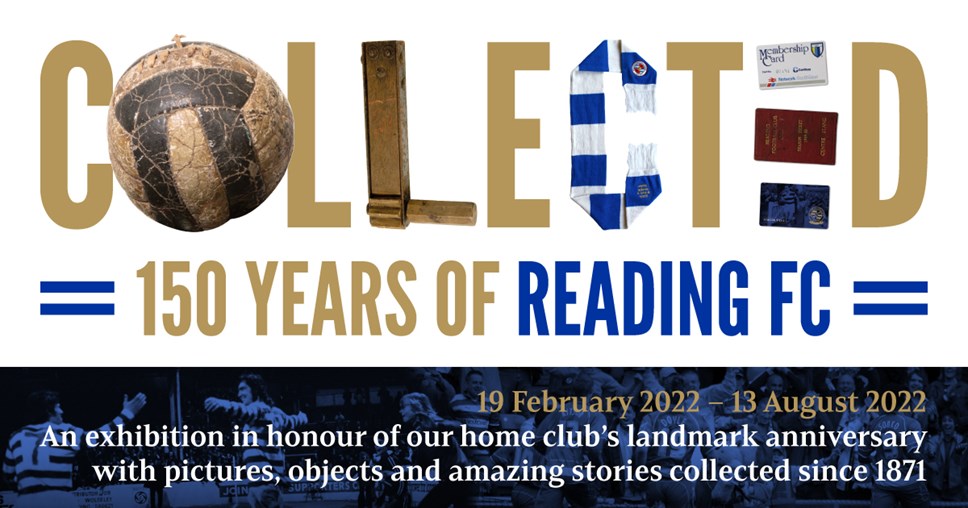
New Exhibition at Reading Museum Celebrates 150 Years of Reading Football Club
- COLLECTED: 150 Years of Reading Football Club is free to visit and open to the public in the Sir John Madejski Art Gallery from Saturday the 19 February 2022
- The exhibition is a once-in-a-lifetime gathering of unique pictures, objects, and fans’ and players’ memorabilia, telling the amazing story of Reading Football Club collected since 1871
- The exhibition forms part of Reading FC’s wider programme of 150th-anniversary celebrations
READING Museum is thrilled to announce details of its latest exhibition, ‘COLLECTED: 150 Years of Reading FC.’
Through a unique gathering of images, ephemera and mementoes, the exhibition tells the incredible story of Reading Football Club’s historic journey, from a group of young townsmen playing on Kings Meadow to the heights of the national game.
With expert interpretation provided by the Club’s community of historians, the exhibition is designed to appeal to fans both old and new, as Reading marks the 150th anniversary of its football club, making it one of the oldest surviving clubs in the Football League.
Objects from STAR (Supporters Trust at Reading) bring this history to life, including never-before-seen photographs from the Club’s history, loans from iconic players such as a shirt worn by all-time fan’s favourite Robin Friday, and a range of items from the personal collection of legendary former Reading FC chairman Sir John Madejski.

The exhibition reflects the important ways the club contributes to the life of our town, with an account of the vital work its Community Trust does in Reading today. It also includes results of recent picture research into the early history of the women’s game in Reading, as well as pinpointing some of the key historical moments of the emergence of people of colour in the professional game.
In producing the exhibition, Reading Museum has worked closely with STAR and is hugely grateful to them, along with Select Car Leasing and Business Moves Group for their generous sponsorship, which has made this once-in-a-lifetime celebration of the Club’s history possible.
Cllr Karen Rowland, Reading’s Lead Councillor for Culture, Heritage and Recreation, said: “I’m delighted to see Reading Museum working with the Supporters Trust at Reading and our community to co-create this exhibition, shedding a light on the incredible story in the life and times of our town and the huge part of our football club continues to play both on and off the pitch. The club means so much to so many – not just here in Reading, but across the world. This exhibition will form a focal point for the club’s fans to both share in and celebrate this amazing history. I know it will galvanise all of us as we look forward to the future for many more successes for the Royals. And what better year to celebrate the club’s 150th anniversary celebrations alongside the Queen’s Platinum Jubilee!
“Come and catch this must-see exhibition and over half term, families can also enjoy fun football-themed trails and activities. Visit the museum’s website www.reagingmuseum.org.uk to find out more.”
Graham Conway, Managing Director of Select Car Leasing, sponsors of the exhibition, said: “We are very pleased to support our local museum's work in presenting the fascinating history of our town. Select is proud to have been associated with Reading FC for many years and to now put our name to the stadium that transformed the Club's fortunes, thanks to the extraordinary vision and hard work of Sir John Madejski. Reflecting on the Club’s 150 years of history and tradition, both on and off the pitch, we encourage everyone to visit the exhibition: to know your history and roar for the Royals.”
Former Reading FC chairman Sir John Madejski, said: “I am very proud of the part that I've played in Reading Football Club's long and illustrious history. I recognise that the Club's identity and character have been shaped by all the fans and all of those who have been involved throughout its history, from players to backroom and technical staff, and it is excellent to see these shared memories brought together in Reading Museum’s latest exhibition.
“I’m delighted to be associated with Reading Football Club’s 150th anniversary, and I feel very honoured to have been able to make a contribution to the club from 1990 to 2016. I am enormously proud of being instrumental in providing the Madejski Stadium, and I will always cherish the wonderful moments on the field of play that we have witnessed there. Most especially perhaps, I treasure my memories of being part of the Club when we first reached the Premier League, the top echelon.
“I look forward to many happy seasons ahead, roaring for the Royals to score at least one more goal than the opposition on the park, contributing to the cultural life of Reading off the pitch, and once again being back in the Premier League where we always belong.”
Roger Titford, STAR Heritage Officer, said: “It’s been enormous fun putting the exhibition together and finding material even I haven’t ever seen. We hope visitors get a full picture of the Club’s history – we’ve had many grand days even before we joined the Football League in 1920. Material from fans forms the bedrock of the exhibition and the contribution of fans to the life of the club is acknowledged.”
‘COLLECTED: 150 Years of Reading FC’ is free to view and runs from Saturday 19 February to 13 August 2022 in the Sir John Madejski Gallery, Reading Museum www.readingmuseum.org.uk
Families are encouraged to bring the kids along this February half term, kicking off with the Big Football Hunt and Bertie the Badger’s Football Nickname Trail, with crafty activities to take home and colour in. For more details visit www.readingmuseum.org.uk/holiday-fun-reading-museum
Ends
Notes to editors
Media opportunity: The media are invited to a private preview event on Monday 21 February from 5 pm-6.30 pm in the Sir John Madejski Art Gallery. Please contact Victoria.Nickless@Reading.gov.uk if you would like to attend.
In attendance: Councillor Rachel Eden, Mayor of Reading; Sir John Madejski; Reading FC Chief Executive, Dayong Pang; Reading Borough Council Leader Jason Brock; Cllr Karen Rowland, Reading’s Lead Cllr for Heritage, Culture and Recreation; former players: Lawrie Sanchez and Bobby Williams and a current first-team player (TBC); representatives from Reading Museum; Reading Football Club; STAR and Select Car Leasing.
History of Reading FC
The story of Reading's home team charts back to late 1871, when a group of young men formed Reading Football Club and began playing matches against local rivals including Maidenhead, Henley, and Marlow.
Success soon followed both for the Club and its players. In 1877, the club entered the FA Cup for the very first time. Two years later, they won their first trophy –the Berks and Bucks Cup. And it wasn’t long before team captain Brownlow Haygarth was selected to play for England.
Reading flourished around 1880 and at the turn of the century but only achieved national status in 1926 when the Club joined the Football League Division 2, which resulted in major clubs like Everton and Manchester City coming to our town. A highlight of the 1920s was reaching the FA Cup semi-final in 1927. The Club became known to fans everywhere as the Biscuitmen, after the world-famous Huntley & Palmer's biscuit factory in the town.
The Club endured a slow decline from the 1930s, spending all its time in the third division. In 1971, the Club's centenary season, Reading was relegated to the fourth division, the bottom of the Football League. At this time the Club had only a very small staff and playing squad, which had to deal with a changing and sometimes dangerous football culture. Nevertheless, characterful players like Robin Friday and Steve Death became hugely popular and are fondly remembered by fans to this day.
The 1970s marked a period of immense change both on the pitch and across the town. Football was all over the television, with hooliganism in the news. Andy Alleyne became the first black player to make his debut for Reading. A Reading women’s football team revived after a long impasse. And finally, after 50 years waiting Reading won promotion in 1976! The club nickname became the ‘Royals’.
These years of triumph and turmoil continued into the 1980s. In 1983, the Club nearly ceased to exist when the disreputable businessman Robert Maxwell attempted to merge it with archrivals Oxford United into an entity dubbed Thames Valley Royals. The threat was only overcome by the combined resistance of both sets of supporters and investment from local businessman, and former, player Roger Smee, who, as new chairman took the Club in a dramatically new and successful direction. Two promotions and a Wembley triumph quickly followed before financial turmoil returned.
The arrival of Sir John Madejski as Chairman in 1990 marked the beginning of a radical change in the Club’s fortunes and another exciting era in its history. In 1998, the move to the Madejski Stadium (now Select Car Leasing Stadium) was a hugely empowering one. The Club has enjoyed two Championship titles and three historic seasons in the Premier League. Today, players are recruited from all over the world, and there has been a huge growth in the support. Over 200 young players are coached at the new Bearwood Park Training Facility in the Category 1 Academy. The women's team competes in the WSL, the highest level of women's football. And the Club's Community Trust reaches out to thousands of people every week.



